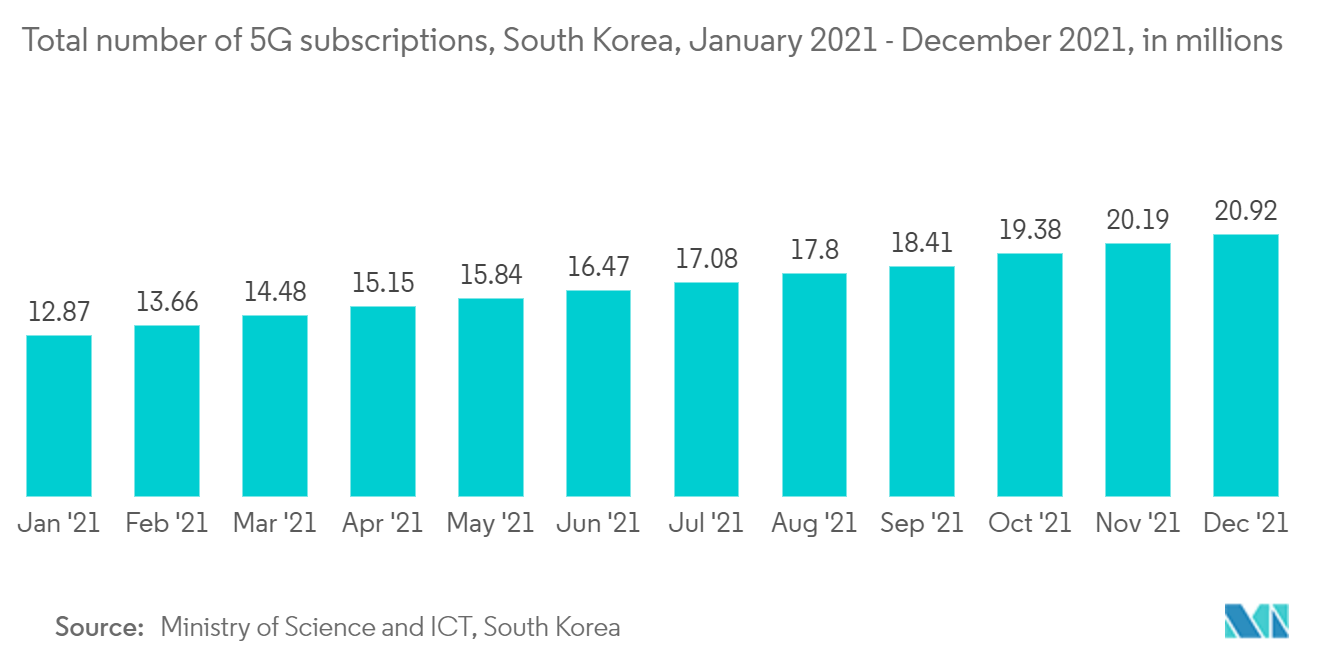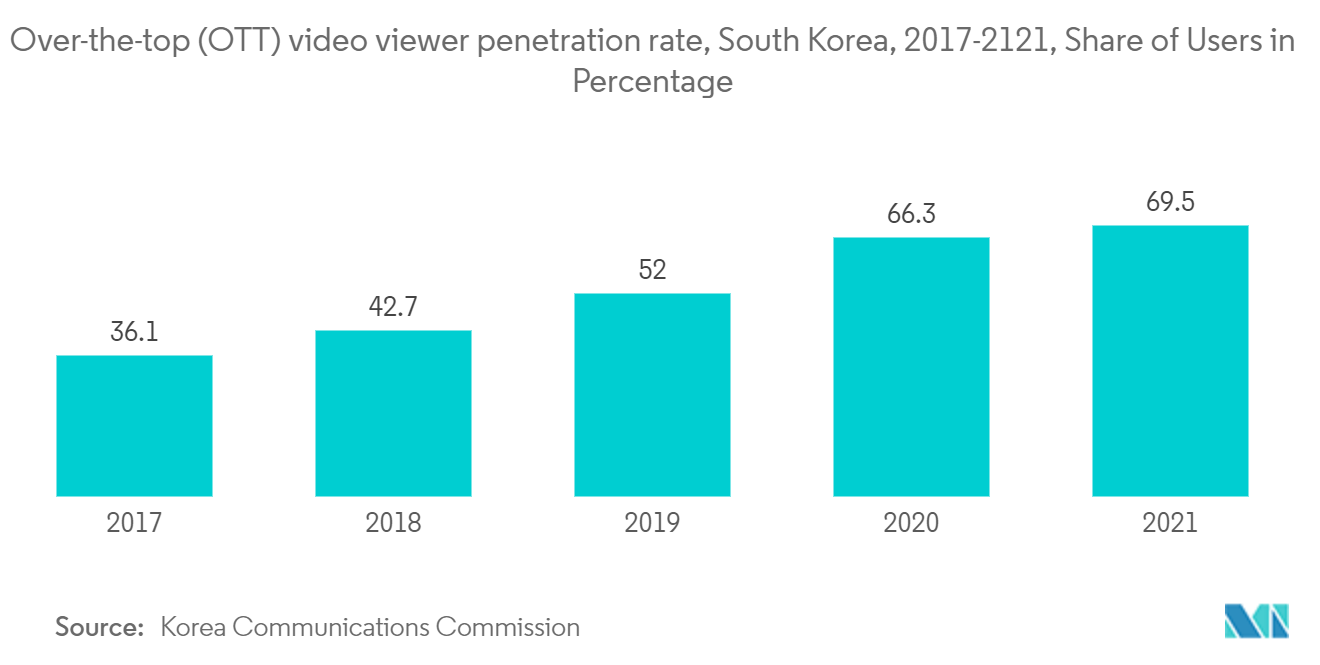Market Trends of South Korea Telecom Industry
This section covers the major market trends shaping the South Korea Telecom Market according to our research experts:
Incredible Availability and Speed of 5G
- South Korea became the first country to provide 5G networks commercially. Presently, 85 of its cities already have 5G services. The introduction of new handsets, notably Apple's new iPhone series, has led to an increase in 5G users nationwide, according to reports from RCR Wireless. As per the report, SK Telecom, the nation's largest mobile operator by subscriptions, had 11.4 million 5G subscribers at the end of the current year, followed by KT with 7.3 million and LG Uplus with 5.2 million.
- Currently, South Korea is the world leader in 5G speed, showing early success in scaling a domestic network and developing an all-encompassing national plan to use the revolutionary potential of 5G fully. The nation's experience demonstrates the government's importance as a crucial enabler for developing the 5G ecosystem, especially in countries with a developed mobile sector. The government employed an open process to develop the next-generation mobile network and offered a clear strategic direction.
- The 5G Impact on the Global Mobile Network Experience study from Open Signal ranked South Korea at number one globally for 5G download speed, with customers reporting download rates of 438 Mbps. South Korea was also rated top globally for 5G reach and availability. The study revealed that South Korean consumers not only had a 5G connection in two-thirds of the places they went but also spent nearly one-third (30.7%) of their time with an active 5G connection.
- Encouragingly, South Korea also has the best 5G voice application experiences, while the nation also tops the charts for 5G gaming. According to a current industry assessment, SK Telecom, the largest cellular carrier in South Korea, scored first internationally for 5G network download speeds. The average download speed across SK Telecom's 5G network was 469.6 megabits per second (Mbps), 2.55 times faster than the 184.2 Mbps average across all worldwide mobile carriers, according to the global mobile industry tracker Opensignal. With 429.6 Mbps, LG Uplus, the third-largest mobile carrier in the nation, came in second, ahead of Vivacom Inc. of Bulgaria, Tele2 AB of Sweden, and KT Corp. of South Korea.
- South Korea is frequently seen as a bellwether for 5G, in part because the nation's regulatory body tracks the technology's uptake in detail. According to Omdia research notes, there were 24.53 million 5G customers in South Korea as of August 2022, making up almost 33% of all mobile subscriptions in the country. More significantly, nearly 70% of the nation's mobile data traffic is currently being carried by 5G networks. That is mainly because the typical 5G user utilizes around 27 GB per month, or over 3.1 times the average 4G user. All these findings depict that South Korea is way ahead of other network providers across the globe in terms of the 5G network.

Steller OTT Services
- South Korea's media and entertainment sector is changing because of content digitization. The South Korean streaming market has had years of rapid expansion, and it is anticipated that this trend will continue. Even before COVID-19, platforms for streaming video were growing. However, COVID-19 dramatically expedited this tendency.
- Due to the globalization of K-pop, K-drama, and Korean culture, there is currently a great demand for Korean material.
- The Korean Film Council (KOFIC) reported in its annual report that Streaming Video on Demand (SVOD) platforms generated USD 58 million in total income in Korea in 2019. In contrast, the aggregate revenue in 2018 was USD 4 million. The figure for 2020 was estimated at USD 100 million. In South Korea, almost every customer has a smartphone. Therefore, any content is readily available to customers in the country. Thus, convenience drives the demand for OTT or SVOD programs. They desire simple content access so they can view it whenever they want, whenever they want, on any device.
- Moreover, there is a greater-than-ever demand in South Korea for video streaming services. The Korea Communications Commission estimates that the market for Korean video streaming is worth around USD 680 million. The over-the-top (OTT) market, which is another name for the streaming industry, encompasses all forms of media services and content made available to users directly online. Media platforms are no longer needed to go through cable providers, broadcasters, and TV networks. The amount of material consumed in Korea is significantly altering as a result, and major actors in the media sector are frantically trying to catch up.
- In South Korea, almost every customer has a smartphone. Therefore, any content is readily available to customers in the country. Thus, convenience drives the demand for OTT or SVOD programs. Consumers desire simple content access so they can view it whenever they want, whenever they want, on any device.
- The monthly rates for many SVOD services are inexpensive because many young people in Korea are switching to these SVOD services. It is far less expensive than seeing a movie in a Korean cinema, where admission plus refreshments may cost at least WON 30,000 (USD 21.14) per person. In Korea, several SVOD services provide high-quality original material.
- The majority of SVOD services in Korea adopt Netflix's marketing approach. This strategy includes producing original material. A growing amount of premium material that would have been distributed in cinemas is now immediately accessible on these channels. The Korean SVOD market is expected to grow much faster in the coming years.
- The most popular video streaming service in South Korea is Netflix. To deliver its content on LG's pay-TV service, Netflix teamed up with LG Uplus Corp. They were able to collaborate with telecom company KT Corp. so that they could provide their services on KT's pay-TV platform Olleh. As a result, Netflix is now available to Olleh TV customers. A combined 35% of Korea's pay-TV market is controlled by the two telecom carriers in South Korea. At present, Netflix has an estimated 9 million paying customers and the highest active user base among OTT providers in the country.

